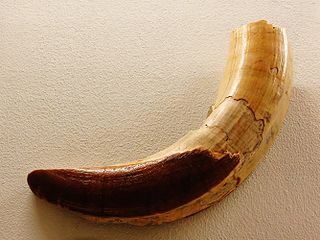
Pyrotherium is an extinct genus of South American ungulate, of the order Pyrotheria, that lived in what is now Argentina and Bolivia, during the Late Oligocene. It was named Pyrotherium because the first specimens were excavated from an ancient volcanic ash deposit. Fossils of the genus have been found in the Deseado and Sarmiento Formations of Argentina and the Salla Formation of Bolivia.

Astrapotheria is an extinct order of South American and Antarctic hoofed mammals that existed from the late Paleocene to the Middle Miocene, 59 to 11.8 million years ago. Astrapotheres were large, rhinoceros-like animals and have been called one of the most bizarre orders of mammals with an enigmatic evolutionary history.
Archaeopithecidae is an extinct family comprising two genera of notoungulate mammals, Teratopithecus and Archaeopithecus, both known from the Eocene of Argentina.
Orophodon is an extinct genus of ground sloth of the family Mylodontidae, endemic to Argentina, South America.

Astrapotheriidae is an extinct family of herbivorous South American land mammals that lived from the Late Eocene to the Middle Miocene 37.71 to 15.98 million years ago. The most derived of the astrapotherians, they were also the largest and most specialized mammals in the Tertiary of South America. There are two sister taxa: Eoastrapostylopidae and Trigonostylopidae.

Parastrapotherium is an extinct genus of South American land mammal that existed from the Late Oligocene to the Early Miocene. The genus includes some of the largest and smallest known astrapotherian, but at present no generally recognized description can adequately characterize it.

Prosotherium is an extinct genus of hegetotheriid notoungulate. It lived during the Late Oligocene, and its fossilized remains were found in South America.
Proadiantus(Ameghino, 1897) is an extinct genus of adianthid litoptern. It lived during the Late Oligocene, in what is today South America. It consists of only 1 species, Proadiantus excavatus.
Proadinotherium is an extinct genus of toxodontid. It lived between the Late Oligocene and the Early Miocene in what is now South America.

Trachytherus is an extinct genus of mesotheriid notoungulate that lived from the Late Oligocene to the Early Miocene in what is now South America.

Isotemnus is an extinct genus of notoungulate belonging to the family Isotemnidae. It lived from the Late Paleocene to the Middle Eocene of what is now Argentina.
Pleurostylodon is an extinct genus of notoungulate belonging to the family Isotemnidae. It lived during the Middle Eocene, in what is now Argentina.
Eurygenium is an extinct genus of notoungulate belonging to the family Notohippidae. It lived during the Late Oligocene in what is today South America.

Morphippus is an extinct genus of notohippid notoungulate that lived during the Middle to Late Oligocene in what is now South America.
Ancylocoelus is an extinct genus of mammal, belonging to the order Notoungulata. It lived during the Late Oligocene, in what is today Argentina, in South America.
Archaeopithecus is an extinct genus of Notoungulate, belonging to the suborder Typotheria. It lived during the Middle Eocene, in what is today Argentina.
Argyrohyrax is an extinct genus of interatheriid notoungulate that lived during the Late Oligocene, of what is now Argentina and Bolivia.
Proeuphractus is an extinct genus of xenarthran, related to the modern armadillos. It lived from the Early to the Late Miocene, and its fossilized remains were discovered in South America.
Glyptatelus is an extinct genus of glyptodont. It lived from the Late Eocene to the Middle Oligocene in what is now Argentina and Bolivia.
Liarthrus is a genus of astrapotheriid mammal known from the Late Oligocene Sarmiento Formation of Santa Cruz Province, Argentina. It was described by the Argentine paleontologist Florentino Ameghino in 1895 along with several other genera from the "Pyrotherium Beds", which were then believed to date to the Cretaceous period. Ameghino described Liarthus on the basis of fragmentary, being only a right astragalus, premolar 4, and an incomplete premolar from the upper jaws. Only one species was described, L. copei, the species name honoring the American paleontologist Edward Drinker Cope, who lived during the same interval as Ameghino. Liarthrus was synonymized with the other astrapothere Parastrapotherium in 1914 by American mammologist Frederic Loomis, though it was revalidated by a 2008 analysis of Parastrapotherium. Liarthrus was a herbivorous mammal, being an astrapothere, which had large tusks on their skulls and mandibles in addition to a large body size.
















